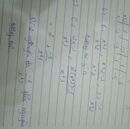
Hãy nhập câu hỏi của bạn vào đây, nếu là tài khoản VIP, bạn sẽ được ưu tiên trả lời.


\(a,\frac{-2,6}{x}=-\frac{12}{42}\)
\(\Leftrightarrow\left(-2,6\right).42=-12x\)
\(\Leftrightarrow-12x=-\frac{546}{5}\)
\(\Leftrightarrow x=\frac{91}{10}\)
\(b,\frac{x^2}{6}=\frac{24}{25}\)
\(\Leftrightarrow25x^2=24.6\)
\(\Leftrightarrow25x^2=144\)
\(\Leftrightarrow x^2=\frac{144}{25}\)
\(\Leftrightarrow x=\frac{12}{5}\)

Trả lời:
a, \(A=\frac{x^2-9}{x^2-6x+9}=\frac{\left(x-3\right)\left(x+3\right)}{\left(x-3\right)^2}=\frac{x+3}{x-3}\)
b, \(B=\frac{9x^2-16}{3x^2-4x}=\frac{\left(3x-4\right)\left(3x+4\right)}{x\left(3x-4\right)}=\frac{3x+4}{x}\)
c, \(C=\frac{x^2+4x+4}{2x+4}=\frac{\left(x+2\right)^2}{2\left(x+2\right)}=\frac{x+2}{2}\)
d, \(D=\frac{2x-x^2}{x^2-4}=\frac{x\left(2-x\right)}{\left(x-2\right)\left(x+2\right)}=-\frac{x\left(x-2\right)}{\left(x-2\right)\left(x+2\right)}=-\frac{x}{x+2}\)
e, \(E=\frac{3x^2+6x+12}{x^3-8}=\frac{3\left(x^2+2x+4\right)}{\left(x-2\right)\left(x^2+2x+4\right)}=\frac{3}{x-2}\)

Trả lời:
a, \(A=\frac{x+5}{x+2}=\frac{x+2+3}{x+2}=\frac{x+2}{x+2}+\frac{3}{x+2}=1+\frac{3}{x+2}\)
Để \(A\inℤ\) thì \(\frac{3}{x+2}\inℤ\)
\(\Rightarrow3⋮x+2\Rightarrow x+2\inƯ\left(3\right)=\left\{\pm1;\pm3\right\}\)
Ta có bảng sau:
| x+2 | 1 | -1 | 3 | -3 |
| x | -1 | -3 | 1 | -5 |
Vậy \(x\in\left\{-1;-3;1;-5\right\}\)
b, \(B=\frac{x+1}{x+2}=\frac{x+2-1}{x+2}=\frac{x+2}{x+2}-\frac{1}{x+2}=1-\frac{1}{x+2}\)
Để A là số nguyên thì \(1⋮x+2\Rightarrow x+2\inƯ\left(1\right)=\left\{\pm1\right\}\)
Ta có bảng sau:
| x+2 | 1 | -1 |
| x | -1 | -3 |
Vậy \(x\in\left\{-1;-3\right\}\)
c, \(C=\frac{2x-1}{x+1}=\frac{2\left(x+1\right)-3}{x+1}=\frac{2\left(x+1\right)}{x+1}-\frac{3}{x+1}=2-\frac{3}{x+1}\)
Để C là số nguyên thì \(3⋮x+1\Rightarrow x+1\inƯ\left(3\right)=\left\{\pm1;\pm3\right\}\)
| x+1 | 1 | -1 | 3 | -3 |
| x | 0 | -2 | 2 | -4 |
Vậy \(x\in\left\{0;-2;2;-4\right\}\)

d, \(\frac{x+1}{9}+\frac{x+2}{8}=\frac{x+3}{7}+\frac{x+4}{6}\)
\(\Leftrightarrow\frac{x+1}{9}+1+\frac{x+2}{8}+1=\frac{x+3}{7}+1+\frac{x+4}{6}+1\)
\(\Leftrightarrow\frac{x+10}{9}+\frac{x+10}{8}-\frac{x+10}{7}-\frac{x+10}{6}=0\)
\(\Leftrightarrow\left(x+10\right)\left(\frac{1}{9}+\frac{1}{8}-\frac{1}{7}-\frac{1}{6}\right)=0\)
\(\Leftrightarrow x+10=0\) (Vì \(\frac{1}{9}+\frac{1}{8}-\frac{1}{7}-\frac{1}{6}\) ≠ 0)
\(\Leftrightarrow x=-10\)
Vậy x = -10 là nghiệm của phương trình.

a: \(B=\left(\dfrac{x}{x\left(x-2\right)\left(x+2\right)}-\dfrac{10}{5\left(x+2\right)}+\dfrac{1}{x-2}\right):\dfrac{x^2-4+6-x^2}{x-2}\)
\(=\left(\dfrac{1}{\left(x-2\right)\left(x+2\right)}-\dfrac{2}{x+2}+\dfrac{1}{x-2}\right):\dfrac{2}{x-2}\)
\(=\dfrac{1-2x+4+x+2}{\left(x-2\right)\left(x+2\right)}\cdot\dfrac{x-2}{2}=\dfrac{-x+7}{2\left(x+2\right)}\)
b: Ta có: |x|=1/2
=>x=1/2 hoặc x=-1/2
Thay x=1/2 vào B, ta được:
\(B=\dfrac{-\dfrac{1}{2}+7}{2\left(\dfrac{1}{2}+2\right)}=\dfrac{13}{10}\)
Thay x=-1/2 vào B, ta được:
\(B=\dfrac{\dfrac{1}{2}+7}{2\left(-\dfrac{1}{2}+2\right)}=\dfrac{5}{2}\)

a, \(A=\frac{x^2+3x-x+3-x^2+1}{x^2-9}\)\(.\frac{x+3}{2}\) \(\left(x\ne3;-3\right)\)
\(A=\frac{2x+4}{\left(x-3\right)\left(x+3\right)}.\frac{x+3}{2}\)\(=\frac{2\left(x+2\right)}{\left(x-3\right)\left(x+3\right)}.\frac{x+3}{2}\)\(=\frac{x+2}{x-3}\)
b, để \(A\in Z\Rightarrow\hept{\begin{cases}x+2⋮x-3\\x-3⋮x-3\end{cases}}\)\(\Rightarrow x+2-x+3=5⋮x-3\)\(\leftrightarrow x+3\in\left(1;5;-1;-5\right)\)
\(\leftrightarrow x\in\left(-2;2;-4;-8\right)\)

a.\(ĐKXĐ:\hept{\begin{cases}x^2-2x\ne0\\x-2\ne0\\x\left(x+1\right)\ne0\end{cases}\Leftrightarrow\hept{\begin{cases}x\left(x-2\right)\ne0\\x-2\ne0\\x\left(x+1\right)\ne0\end{cases}\Leftrightarrow}\hept{\begin{cases}x\ne0\\x\ne2\\x\ne-1\end{cases}}}\)
b.\(M=\left(\frac{1}{x^2-2x}+\frac{2}{x-2}\right)\div\frac{2x+1}{x\left(x+1\right)}\)
\(=\left(\frac{1}{x\left(x-2\right)}+\frac{2}{x-2}\right)\div\frac{2x+1}{x\left(x+1\right)}\)
\(=\left(\frac{1}{x\left(x-2\right)}+\frac{2x}{x\left(x-2\right)}\right)\div\frac{2x+1}{x\left(x+1\right)}\)
\(=\frac{2x+1}{x\left(x-2\right)}\div\frac{2x+1}{x\left(x+1\right)}\)
\(=\frac{2x+1}{x\left(x-2\right)}.\frac{x\left(x+1\right)}{2x+1}=\frac{x\left(2x+1\right)\left(x+1\right)}{x\left(x-2\right)\left(2x+1\right)}=\frac{x+1}{x-2}\)
c.Để \(M>1\)thì
\(\frac{x+1}{x-2}>1\)
c, Ta có : \(M>1\Rightarrow\frac{x+1}{x-2}>1\Leftrightarrow\frac{x+1}{x-2}-1>0\)
\(\Leftrightarrow\frac{x+1-x+2}{x-2}>0\Leftrightarrow\frac{3}{x-2}>0\)
\(\Rightarrow x-2>0\Leftrightarrow x>2\)vì 3 > 0
d, Để M nguyên khi \(x+1⋮x-2\Leftrightarrow x-2+3⋮x-2\)ĐK : \(x\ne2\)
\(\Leftrightarrow3⋮x-2\Rightarrow x-2\inƯ\left(3\right)=\left\{\pm1;\pm3\right\}\)
| x - 2 | 1 | -1 | 3 | -3 |
| x | 3 | 1 | 5 | -1 |

\(e ) Để \) \(M\)\(\in\)\(Z \) \(thì\) \(1 \)\(⋮\)\(x +3\)
\(\Leftrightarrow\)\(x + 3 \)\(\in\)\(Ư\)\((1)\)\(= \) { \(\pm\)\(1 \) }
\(Lập\) \(bảng :\)
| \(x +3\) | \(1\) | \(- 1\) |
| \(x\) | \(-2\) | \(- 4\) |
\(Vậy : Để \) \(M\)\(\in\)\(Z\) \(thì\) \(x\)\(\in\){ \(- 4 ; - 2\) }
e) Để M \(\in\)Z <=> \(\frac{1}{x+3}\in Z\)
<=> 1 \(⋮\)x + 3 <=> x + 3 \(\in\)Ư(1) = {1; -1}
Lập bảng:
| x + 3 | 1 | -1 |
| x | -2 | -4 |
Vậy ....
f) Ta có: M > 0
=> \(\frac{1}{x+3}\) > 0
Do 1 > 0 => x + 3 > 0
=> x > -3
Vậy để M > 0 khi x > -3 ; x \(\ne\)3 và x \(\ne\)-3/2



\(-\frac{2,6}{x}=-\frac{12}{42}\)
\(-2,6\cdot42=-12\cdot x\)
\(\frac{109,2}{12}=x\Rightarrow x=9,1\)